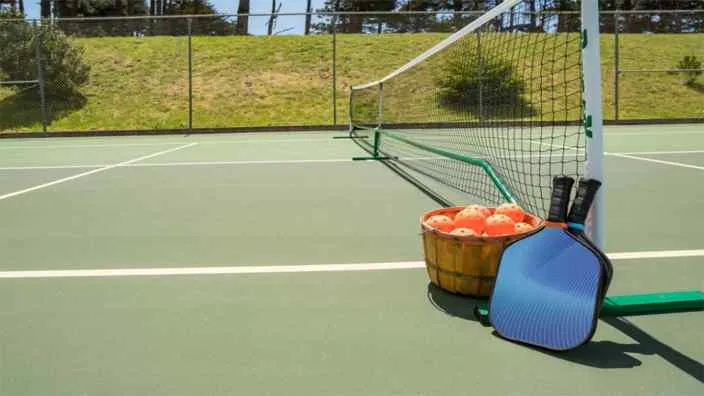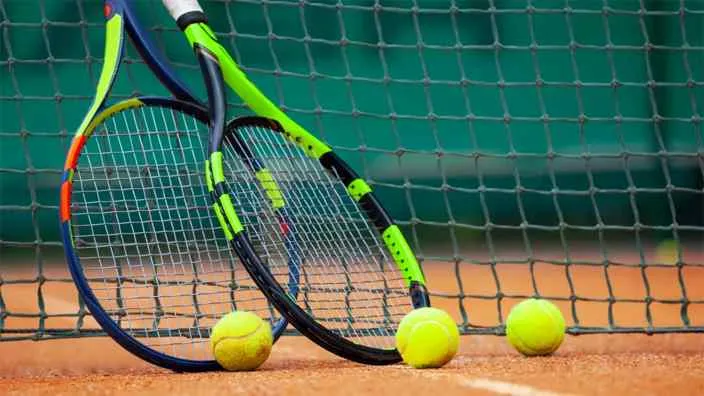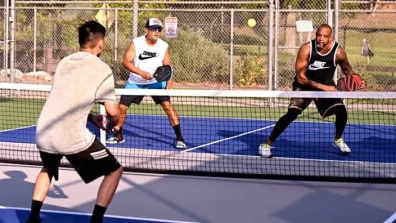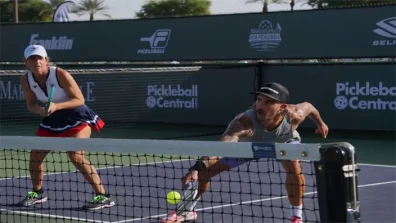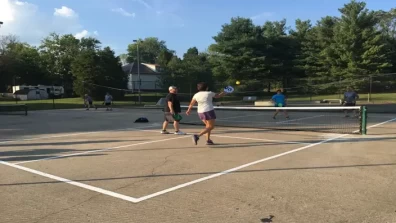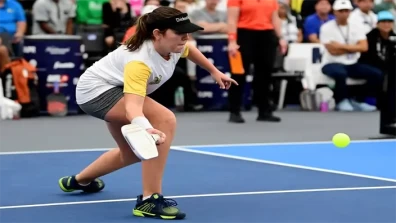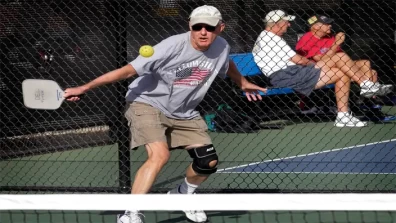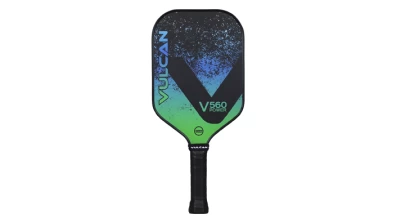Pickleball has exploded in popularity over the past decade, growing from 500 pickleball courts in the US to over 8,500 courts today. With its growth outpacing sports like tennis, many players are left wondering - can I use my tennis net for pickleball too? Let’s find out if you can.
Quick Answer: Pickleball is generally played on a smaller court with a different paddle and ball than tennis. It's a bit easier for beginners, but both sports have their unique charm.
Table of Contents
- Differences Between Pickleball & Tennis Nets
- Similarities Between Pickleball & Tennis Nets
- How To Choose The Right Pickleball Net?
- Different Types Of Tennis Nets
- Top 3 Common Questions About Pickleball & Tennis Nets
- 5 Ways To Maintain Your Pickleball & Tennis Nets
- Frequently Asked Questions
- Conclusion
Differences Between Pickleball & Tennis Nets
While pickleball nets and tennis nets may look similar at first, there are some key differences that highly impact gameplay.
- Height - Pickleball nets are 36 inches tall at the center while tennis nets are 42 inches tall, allowing for different serve styles.
- Flexibility - Pickleball nets have more give to account for slower ball speeds. Tennis nets are taut to avoid interfering with serves up to 130+ mph.
- Shape - Pickleball nets must hang flat to rebound pickleballs, while tennis nets can sag in the middle since tennis balls don't bounce off the net.
- Materials - Pickleball favors lightweight, weather-resistant portable nets while tennis uses heavier-duty netting and posts for year-round outdoor use.
- Support - Pickleball nets often use a single center pole vs. tennis' heavier dual sideline posts anchored in the court.
Similarities Between Pickleball & Tennis Nets
However, with differences come similarities - pickleball and tennis nets share quite a few design elements that players may find interchangeable.
- Dimensions - Both nets are 21 feet 6 inches long and extend 2 feet outside singles court boundaries.
- Mesh size - Pickleball and tennis nets have similar mesh dimensions to stop balls while allowing visibility.
- Posts - Posts for both nets are placed 3 feet outside court lines and can be removable or permanent.
- Configuration - Nets get tighter from top to bottom to allow ball passage but prevent missed shots from going out.
How To Choose The Right Pickleball Net?
You’d be surprised to know that Pickleball has grown from 50 players in 1965 to over 4.8 million today! With portable and permanent pickleball net options, it can be challenging to select the ideal net for your play style, space, and budget. Here’s a quick guide:
1- Correct Pickleball Net Height
- Regulation height is 36 inches at the center and 34 inches at the posts.
- Allows underhand serves and dink shots key to pickleball strategy.
- Ideal for indoor or outdoor-sanctioned tournament dimensions.
- Adjustable nets accommodate different skill levels. Lower for beginners.
2- Pickleball Net Material
- Nylon or vinyl-coated polyester are most common.
- Look for durability, weather resistance, and UV protection.
- Lighter portable nets around 10-15 lbs. Permanent nets are heavier.
- Pick a manageable weight for your setup/takedown needs.
3- Pickleball Net Size
- The regulation size is 22 feet wide x 36 inches high.
- Fits singles court (20x44 feet) and doubles (20x60 feet).
- Larger club nets accommodate multiple courts.
- Consider a minimum of 2 feet of coverage beyond court lines.
Different Types Of Tennis Nets
However, if you’re thinking of getting a tennis net - here’s some helpful info for you:
1- Portable Tennis Nets
- Typically 10-20 pounds for easy setup and takedown.
- Center poles allow play on any flat surface; no ground anchors.
- More affordable at initial cost but requires storage space.
- Prone to folding over if hit; less taut than permanent nets.
- Ideal for driveway, backyard play, and communities with shared courts.
2- In-Ground Tennis Nets
- Permanently installed in-court surface with sleeves and anchors.
- Taut, stationary; high tension withstands impact from balls and players.
- Long-lasting but fixed in place; only for dedicated tennis courts.
- More costly upfront but extremely durable for years of play.
- Required for official competition per USTA standards.
3- Retractable Tennis Nets
- In-ground side posts allow the net to slide down below the playing surface.
- Converts court for multiple sports like pickleball, badminton, and volleyball.
- Mechanized reels make setting up and taking down the net easy.
- Much pricier than other net types but maximizes court usage.
- Ideal for clubs, schools, and parks seeking multi-sport courts.
Top 3 Common Questions About Pickleball & Tennis Nets
With a lot of buzz surrounding pickleball and tennis nets - we answered the most asked questions on the internet, saving you the hassle of searching around!
Why Are Pickleball & Tennis Nets Different Heights?
An average Pickleball net is 36 inches tall and that’s because underhand serves are mainly used in Pickleball, while tennis net height is 42 inches as it accommodates overhead serves done at faster speeds.
Why Do The Nets Have A Dip In The Middle?
The reason behind the dip or sag in the middle of the nets is flexibility. As it absorbs impact from the balls. It also allows properly hit shots that just clear the net to drop inbounds.
The taller tennis net impacts the serving and scoring strategy in pickleball. Precision dinks and net shots become less viable, reducing key elements that define pickleball. Long story short, yes it does ruin the game.
Related Post: How To Return A Spin Serve In Pickleball
5 Ways To Maintain Your Pickleball & Tennis Nets
With over 4.8 million pickleball players and 17.7 million tennis players in the US, keeping nets in top shape keeps games fair and fun.
- Protect from UV - Sun exposure damages net materials. Use UV-resistant nets and keep them covered when not in use. Indoor storage is ideal if possible.
- Manage Tension - Nets lose tension over time. Tighten regularly, and check for sagging especially at the center. Proper tension reduces contact with the ball/players.
- Clean Thoroughly - Dirt, grime, and debris affect net integrity and playability. Brush off surface dirt then use a soft bristle brush and mild cleaner for stubborn buildup.
- Avoid Abrasions - Nets get abraded from pickleballs, racquets, and shoes. Look for rips or holes frequently, and patch small holes before they expand.
- Consider Replacement - With average life spans of around 5 years for portable nets and 10 years for permanent nets, budget for replacements over time.
Frequently Asked Questions
Can You Play Pickleball With A Tennis Net?
While it's possible to play pickleball with a tennis net, the 7-inch height difference impacts serving and volleying. Pickleball nets are 36 inches at center for underhand serves versus 42 inches for tennis overhead serves.
How Do You Adjust A Tennis Net For Pickleball?
To adjust a tennis net for pickleball, detach one end and ratchet it down to lower the center height to 36 inches. Refasten the end and ensure the net still extends 2 feet past court lines before play.
What Type Of Net Is Used In Pickleball?
Pickleball nets are made of weather-resistant mesh, measure 36 inches high at the center and 34 inches at the posts, and span 22 feet wide to fit singles and doubles court sizes.
What Is Pickleball Net Height?
The regulation pickleball net height is 36 inches at the center of the net tapering down to 34 inches at either end where it attaches to the net posts. The reason why it's low is because of basketball’s unique serving style.
Conclusion
As pickleball’s popularity grows, understanding pickleball specifications helps new players get the most enjoyment out of this sport. With its unique gameplay, Pickleball continues to create its own dedicated community while tennis offers a full-court experience of skill and finesse. Ultimately, the decision to stick with tennis or give pickleball a shot is entirely up to you.

